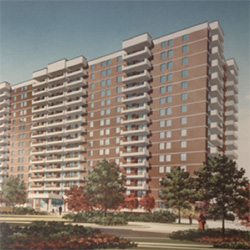The following information comes from a legal opinion prepared by Perley-Robertson, Hill & McDougall.
In Ontario, condominium corporations are subject to the Condominium Act, 1998, which is silent on the issue of smoking. Condominium corporations are created by the registration by the owner of the property of the declaration and description and, prior to such registration, do not exist in law. The declaration deals with the framework of the condo corporation–it is the equivalent to its constitution. It may specify conditions or restrictions with respect to the occupation and use of the units or common elements (section 7 (4) (b)). Once registered, the declaration can only be changed with regard to conditions and restrictions on the occupation and use of the units or common elements by the condo corporation board of directors enacting the change and the owners of at least 80% of the units consenting to the change. The description includes the plans which focus on the boundaries of the units and common elements.
Once created, a condo corporation is governed by a board of directors elected by the members of the corporation. The board of directors enacts bylaws which tend to deal with matters of corporate governance and management issues. Before taking effect a bylaw enacted by the board must be approved by a majority of the condo unit owners. Section 56 (1) of the Act provides that the bylaws may govern the maintenance of the units and common elements (paragraph (j)) and govern the management of the property (paragraph (l)).
The board of directors of a condo corporation may also, pursuant to section 58 (1) of the Act, make rules respecting the use of the common elements and the units to:
(a) promote the safety, security or welfare of the owners and of the property and assets
of the corporation; or
(b) prevent unreasonable interference with the use and enjoyment of the common
elements, the units of the assets of the corporation.
Section 58 (2) of the Act provides: “The rules shall be reasonable and consistent with this Act, the declaration and the bylaws.” Rules made by a condo corporation board of directors take effect 30 days after notice of them is given to the unit owners unless the unit owners require a meeting of owners which can amend or repeal rules.
Accordingly, a condominium corporation could conceivably establish a no-smoking policy in any of the declaration or the rules.
Download the Condominium Act, 1998.
Tenants have to follow the rules, bylaws, and the condo’s declaration. This means if the condo establishes a smoke-free policy, tenants are required to abide by it.
However, when a condo owner rents out his or her unit, a landlord and tenant relationship is established. Residential tenancy relationships in Ontario are governed by the Residential Tenancies Act, 2006 (RTA). The Act details the rights and responsibilities of landlords and tenants of residential premises. The Act also provides a means of settling disputes at the Landlord and Tenant Board.
It is legal for a landlord to adopt a no-smoking policy for his or her condo unit. Landlords have the right to impose additional obligations or restrictions on tenants beyond the standard lease agreement, as long as these requirements do not conflict with the Residential Tenancies Act, the Ontario Human Rights Code, or any other laws.
However, a no-smoking policy would only apply to new tenants signing new leases. Section 38 (1) of the Act states that if a tenancy agreement for a fixed term has ended and the tenancy has not been renewed or terminated, the landlord and tenant shall be deemed to have renewed it as a monthly tenancy agreement containing the same terms and conditions that are in the expired tenancy agreement. Existing tenants who want to smoke in their units would be “grandfathered,” meaning they would be permitted to continue smoking in their units for the length of their tenancy.
If a tenancy agreement does not include a no-smoking clause, and the condo corporation itself has not implemented a smoking ban, a tenant is permitted to smoke in his or her rented condo unit.
This may not mean that a tenant has an absolute right to smoke regardless of others in the building. Section 22 states that a landlord shall not interfere with a tenant’s reasonable enjoyment of the unit, which could include doing nothing about second-hand smoke infiltration from neighbouring units (provided they are also in the landlord’s possession).
While the law does not specifically mention second-hand smoke as grounds for a breach of reasonable enjoyment, there have been legal cases in Ontario where second-hand smoke infiltration, causing a significant disturbance, has been successfully argued as a breach of reasonable enjoyment.
However, things can become tricky when second-hand smoke is entering an owner-occupied unit from a rented condo unit. In this situation, the Residential Tenancies Act, 2006 has no jurisdiction. The condo owner who is being involuntarily exposed can either try talking directly to the tenant about the problem or can contact the landlord and deal with them owner to owner. See the common questions section for more information.
- Download the Residential Tenancies Act, 2006.
In Ontario, smoking tobacco and cannabis and vaping any substance is prohibited in the indoor common areas of multi-unit housing including foyers, elevators, stairwells, laundry rooms, corridors, etc. However, the Act does not apply in situations where people are sharing “common areas” within private units such as kitchens, living rooms and bathrooms, such as when they rent a bedroom in a house but share a kitchen and bathroom. In certain situations, such as the provision of daycare or home health care, the Act recognizes private dwellings as workplaces and smoking is also prohibited.
The law allows certain types of residences that are also workplaces to provide “controlled smoking areas” (also known as designated smoking rooms) for the use of residents only, provided they are separately enclosed, meet strict ventilation requirements, and are only used by residents who are able to smoke independently. By law, the following types of multi-unit facilities are permitted to have controlled smoking areas:
- Nursing homes, charitable homes for the aged, supportive housing residences;
- Retirement homes that provide care;
- Psychiatric facilities; and
- Residential facilities for veterans.
Hotels and other types of temporary guest accommodations are explicitly exempted from Ontario’s smoke-free legislation, meaning that smoking is permitted in private rooms unless the hotel has adopted a no-smoking policy.
- Read the Smoke-Free Ontario Act.
- For more information, visit Smoke-Free Ontario.
The Human Rights Code gives Ontarians equal rights and opportunities on such matters as employment, housing and services. The Code provides protection from discrimination on the basis of race, ancestry, place of origin, colour, ethnic origin, citizenship, creed, sex, sexual orientation, disability, age, marital status, family status, being a recipient of public assistance and record of offences. When there is a conflict between the Code and another Ontario law, the Code usually has priority.
In a housing context, the Human Rights Code contains some provisions of interest concerning smoking and no-smoking policies – sections 2 (1), 11 (1) (a) and 17 (1) and (2). It is possible that a tenant could file an application at the Human Rights Tribunal of Ontario on the basis that the landlord did not take reasonable steps to resolve a problem of second-hand smoke infiltrating his or her unit from a neighbouring unit. A tenant who suffers from a disability that is made worse by second-hand smoke, such as asthma or allergies, could take the position that the landlord has a responsibility to limit or ban smoking in order to accommodate the tenant’s disability.
On the flip side, smoking is not identified in the Code as a ground for protection. In 2007 the Ontario Human Rights Commission (OHRC) published a report on rental housing and human rights, which concluded that “there are conflicting decisions as to whether or not smoking can be considered a disability and whether allowing people to smoke is an appropriate accommodation.” In 2009 the OHRC published Policy on Human Rights and Rental Housing. Section 6.1 deals with smoking, and concludes by stating:
“A housing provider has a duty to explore accommodation requests from tenants with any form of disability. Tenants may also be asked to cooperate and help facilitate the provision of accommodation for themselves, and where appropriate, for their fellow tenants as well.”
However, given the inherent risks associated with smoking, a housing provider may have little or no obligation to accommodate a tenant’s need to smoke when to do so would amount to undue hardship, for example, by negatively affecting the health and safety of other tenants.
This issue of smoking as a disability has been considered a number of times over the years, and Canadian courts have consistently ruled–with one exception–that addiction to nicotine is not a disability. The one exception was a British Columbia Labour Relations Board decision in an employment context. Cominco, a nickel smelter, had banned smoking on the plant site, and while the Board found that the ban discriminated against heavily addicted smokers, it also recognized that the employer’s no-smoking policy was reasonable and was adopted to protect non-smokers from a known hazard. The matter was referred back to the parties to resolve how to accommodate the heavily addicted smokers and Cominco’s smoking ban remains in effect today.
It is important to note that this decision applied to an employment situation. With respect to housing, it is unlikely that an arbitrator or judge would prefer to have tenants be continually exposed to second-hand smoke rather than infringe on someone else’s supposed right to smoke. Just because someone exercises their freedom to smoke does not mean they have an absolute right to smoke.
The key issue is nicotine withdrawal. Even if in the future an adjudicator or judge ruled a tenant’s smoking as a disability, the focus then becomes one of reasonable accommodation by the landlord to the point of undue hardship. This could potentially include the provision of an outdoor smoking area, physical modifications to the smoker’s unit or provision of nicotine replacement therapy, etc.
It should also be noted that a disability designation is individual. If a judge were to rule that a smoking tenant was disabled, it does not mean that all smokers in Ontario would also be recognized as disabled.
- Download the Ontario Human Rights Code.
- Read the Guide to Your Rights and Responsibilities Under the Human Rights Code.
- View the Human Rights and No-Smoking Policies for Multi-Unit Dwellings fact sheet.
- Read more on smoking and human rights case law.
There are several examples of case law in Ontario regarding second-hand smoke in multi-unit housing. A few examples are shown below:
Landlord initiated, no policy in place
| Case number | Reason for application | Outcome |
|---|---|---|
| TSL-81570-17 | Landlord applied for order to terminate tenancy for smoking cannabis. | Tenancy was terminated. Tenant to pay cost of application ($190). |
Other cases are listed below:
LEARY V. STRATA PLAN VR1001, 2016 BCHRT 139 (SEPTEMBER 21, 2016)
- Read the decision
“BALCONY SMOKERS LIKELY VIOLATE CONDOMINIUM ACT”, TORONTO STAR FEBRUARY 2017
- Read the article
THE OWNERS, STRATA PLAN NW 1815 V. ARADI
- Read the decision
SHARON MACKAY V. METROPOLITAN TORONTO CONDOMINIUM CORP, 2014 ONSC 2863 (MAY 2014)
- Read the decision.
- Read the endorsement on costs.
- Read Bob Aaron’s Toronto Star column about the case.






